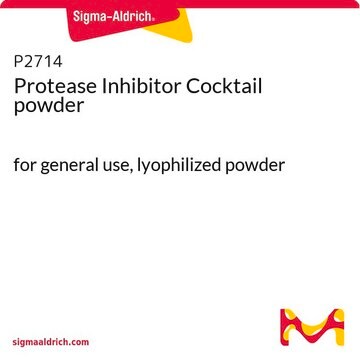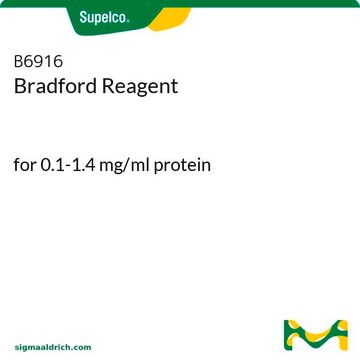This product is packaged in a 4L amber glass bottle with a teflon-lined polypropylene screw cap. Unfortunately, an image is not available.
34998
Acétonitrile
≥99.9%, HPLC Plus, suitable for IR spectroscopy, HPLC
Synonyme(s) :
ACN, Cyanométhane, Cyanure de méthyle, Éthylnitrile
About This Item
Produits recommandés
Nom du produit
Acétonitrile, HPLC Plus, ≥99.9%
Qualité
HPLC Plus
Niveau de qualité
Densité de vapeur
1.41 (vs air)
Pression de vapeur
72.8 mmHg ( 20 °C)
Essai
≥99.9%
Forme
liquid
Température d'inflammation spontanée
973 °F
Limite d'explosivité
16 %
baseline drift measuring range
≤12 mAU (210 nm)
Technique(s)
HPLC: suitable
IR spectroscopy: suitable
Impuretés
≤0.0001% free alkali (as NH3)
≤0.0002% non-volatile matter
≤0.001% free acid (as CH3COOH)
≤0.01% water (Karl Fischer)
≤0.5 ppb fluorescence (quinine) at 254 nm
≤0.5 ppb fluorescence (quinine) at 365 nm
Résidus halogénés
10 ng/L (as heptachlor epoxide)
Indice de réfraction
n20/D 1.344 (lit.)
pb
81-82 °C (lit.)
Pf
−45 °C (lit.)
Densité
0.786 g/mL at 25 °C (lit.)
Gradient HPLC
≤0.2 mAU at 254 nm
≤1 mAU at 210 nm
λ
H2O reference
Absorption UV
λ: 195 nm Amax: ≤0.10
λ: 200 nm Amax: ≤0.02
λ: 228 nm Amax: ≤0.005
λ: 235 nm Amax: ≤0.0044
λ: 250 nm Amax: ≤0.0044
λ: 400 nm Amax: ≤0.0044
Application(s)
food and beverages
Format
neat
Chaîne SMILES
CC#N
InChI
1S/C2H3N/c1-2-3/h1H3
Clé InChI
WEVYAHXRMPXWCK-UHFFFAOYSA-N
Vous recherchez des produits similaires ? Visite Guide de comparaison des produits
Description générale
Application
Spectrométrie de masse, HPLC, CCM, GPC, UV, IR, GC, analyse des résidus de pesticides, synthèse et purification d'ARN/ADN.
Conditionnement
Notes préparatoires
Autres remarques
- L'article réf. 34998-4X2.5L va être supprimé. Nous vous invitons à le commander au flacon sous la référence 34998-2.5L (article physiquement identique et soumis exactement aux mêmes spécifications).
- L'article réf. 34998-6X1L va être supprimé. Nous vous invitons à le commander au flacon sous la référence 34998-1L (article physiquement identique et soumis exactement aux mêmes spécifications).
Produits recommandés
Informations légales
Mention d'avertissement
Danger
Mentions de danger
Classification des risques
Acute Tox. 4 Dermal - Acute Tox. 4 Inhalation - Acute Tox. 4 Oral - Eye Irrit. 2 - Flam. Liq. 2
Code de la classe de stockage
3 - Flammable liquids
Classe de danger pour l'eau (WGK)
WGK 2
Point d'éclair (°F)
35.6 °F - closed cup
Point d'éclair (°C)
2.0 °C - closed cup
Faites votre choix parmi les versions les plus récentes :
Déjà en possession de ce produit ?
Retrouvez la documentation relative aux produits que vous avez récemment achetés dans la Bibliothèque de documents.
Les clients ont également consulté
Protocoles
HPLC Analysis of DMB-Labeled Sialic Acids on Ascentis ® Express RP-Amide: Comparison of Biosimilars to Reference Materials
HPLC Analysis of Vitamins B1, B6 and B12 using Ascentis® Express RP-Amide
-
What kind of container is used for the 4L? Is a photo available?
1 answer-
Helpful?
-
-
What kind of container is used for the 20L? Is a photo available?
1 answer-
This product is packaged in a 20 liter HDPE drum. Please see the picture attached below.
Helpful?
-
-
How is shipping temperature determined? And how is it related to the product storage temperature?
1 answer-
Products may be shipped at a different temperature than the recommended long-term storage temperature. If the product quality is sensitive to short-term exposure to conditions other than the recommended long-term storage, it will be shipped on wet or dry-ice. If the product quality is NOT affected by short-term exposure to conditions other than the recommended long-term storage, it will be shipped at ambient temperature. As shipping routes are configured for minimum transit times, shipping at ambient temperature helps control shipping costs for our customers. For more information, please refer to the Storage and Transport Conditions document: https://www.sigmaaldrich.com/deepweb/assets/sigmaaldrich/marketing/global/documents/316/622/storage-transport-conditions-mk.pdf
Helpful?
-
-
How can I determine the shelf life / expiration / retest date of this product?
1 answer-
If this product has an expiration or retest date, it will be shown on the Certificate of Analysis (COA, CofA). If there is no retest or expiration date listed on the product's COA, we do not have suitable stability data to determine a shelf life. For these products, the only date on the COA will be the release date; a retest, expiration, or use-by-date will not be displayed.
For all products, we recommend handling per defined conditions as printed in our product literature and website product descriptions. We recommend that products should be routinely inspected by customers to ensure they perform as expected.
For products without retest or expiration dates, our standard warranty of 1 year from the date of shipment is applicable.
For more information, please refer to the Product Dating Information document: https://www.sigmaaldrich.com/deepweb/assets/sigmaaldrich/marketing/global/documents/449/386/product-dating-information-mk.pdfHelpful?
-
-
What are the options for drying solvents?
1 answer-
Sigma-Aldrich offers a full range of high-purity solvents with extremely low water levels specifically manufactured for moisture sensitive Organic and Biotech applications. Sigma-Aldrich also carries various drying agents such as molecular sieves, which are typically compatible with organic solvents.
Helpful?
-
-
Can you recommend a Solvent Extractor for organics from aqueous solution?
1 answer-
Solvent extractors are often used for the quantitative extraction of organics from aqueous solutions and separations in immunoassays. The MIXXOR system has been applied successfully in many laboratory solvent extraction operations and is ideal for the rapid screening of alternative solvents for specific extraction problems.
Helpful?
-
-
What apparatus do you recommend for HPLC solvent filtration?
1 answer-
The Sigma-Aldrich Vacuum Filtration Assembly gives you all the components you need including: funnel top, fritted glass funnel support, filtration flask, aluminum clamp, and silicone stopper. The Acrodisc Syringe Filters offer high quality filtration for analytical samples, certified for HPLC to ensure low extractable and available in a broad range of membranes to meet sample compatibility requirements.
Helpful?
-
-
What is the Department of Transportation shipping information for this product?
1 answer-
Transportation information can be found in Section 14 of the product's (M)SDS.To access the shipping information for this material, use the link on the product detail page for the product.
Helpful?
-
-
Who do I contact about larger solvent volume needs?
1 answer-
Email us at [email protected] or visit Sigma-Aldrich Fine Chemicals for development and manufacturing-scale inquiries: [email protected]
Helpful?
-
Active Filters
Notre équipe de scientifiques dispose d'une expérience dans tous les secteurs de la recherche, notamment en sciences de la vie, science des matériaux, synthèse chimique, chromatographie, analyse et dans de nombreux autres domaines..
Contacter notre Service technique





